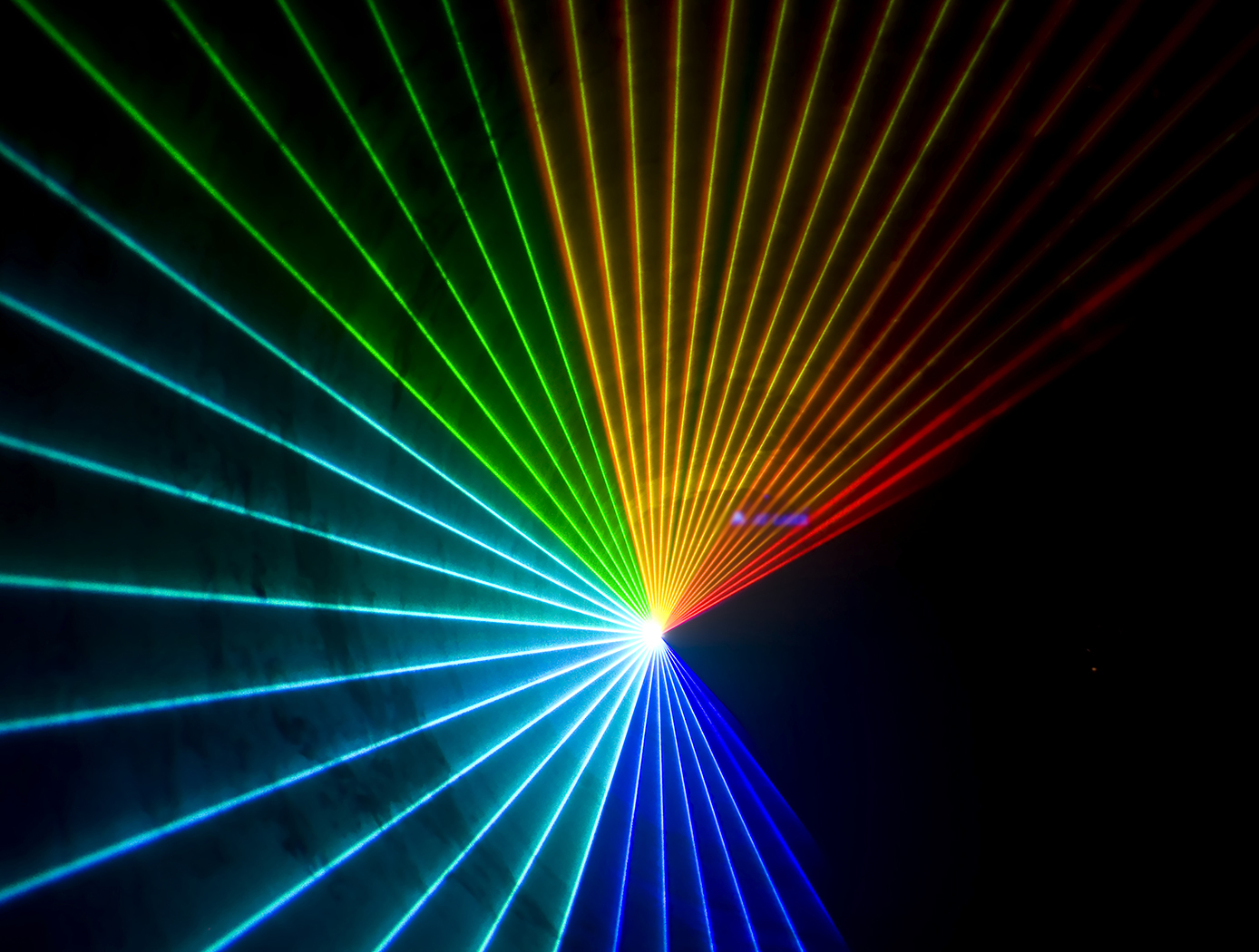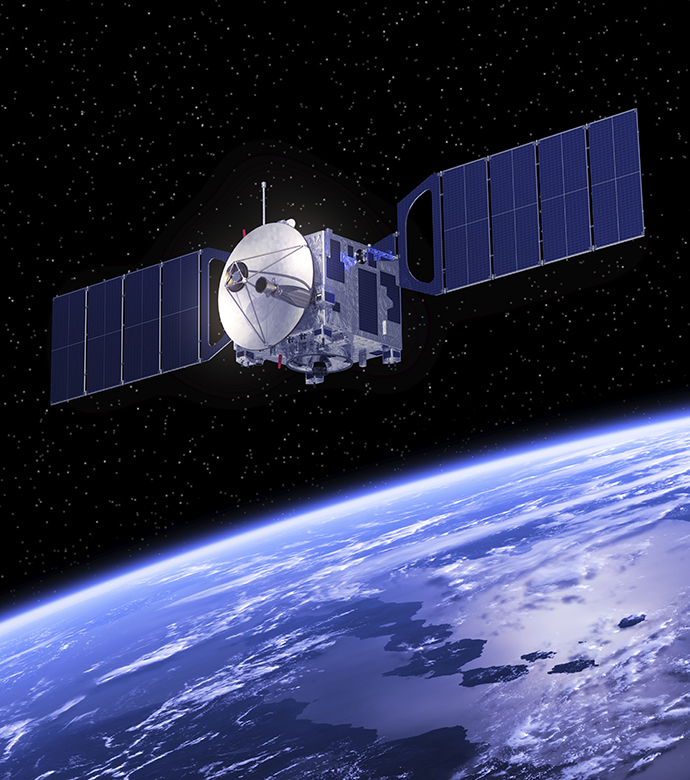Optical Tunable-Based Transmitter for Multiple High-Frequency Bands
Communications
Optical Tunable-Based Transmitter for Multiple High-Frequency Bands (LEW-TOPS-63)
Eliminates the need to have separate transmitters for each frequency
Overview
As the demand grows for more radio frequency (RF) carrier bands in space communication systems, so does the need for a cost-effective compact optical transmitter that is capable of efficiently transmitting multiple RF bands. Traditionally, when a satellite transmits to another satellite or a ground station, a separate terminal with a corresponding antenna is needed for each radio frequency band. Equipment becomes more complex as frequencies get higher. At the higher bands, large heat sinks are needed to dissipate the waste heat. Now, however, innovators at NASA's Glenn Research Center have successfully developed a method using a single laser beam to combine and transmit - all in one unit - multiple microwave bands with different modulation formats and bandwidths. This breakthrough benefits space communication systems in important ways, including reduced size, weight, and complexity, with consequent savings in cost. With additional development, the technology could be extended to fiber optic systems for terrestrial applications.
The Technology
NASA Glenn's researchers have developed a means of transporting multiple radio frequency carriers through a common optical beam. In contrast to RF infrastructure systems alone, this type of hybrid RF/optical system can provide a very high data-capacity signal communication and significantly reduce power, volume, and complexity. Based on an optical wavelength division multiplexing (WDM) technique, in which optical wavelengths are generated by a tunable diode laser (TDL), the system enables multiple microwave bands to be combined and transmitted all in one unit. The WDM technique uses a different optical wavelength to carry each separate and independent high-frequency microwave band (e.g., L, C, X, Ku, Ka, Q, or higher bands). Since each RF carrier operates at a different optical wavelength, the tunable diode laser can, with the use of an electronic tunable laser controller unit, adjust the spacing wavelength and thereby minimize any crosstalk effect.
Glenn's novel design features a tunable laser, configured to generate multiple optical wavelengths, along with an optical transmitter. The optical transmitter modulates each of the optical wavelengths with a corresponding RF band and then encodes each of the modulated optical wavelengths onto a single laser beam. In this way, the system can transmit multiple radio frequency bands using a single laser beam. Glenn's groundbreaking concept can greatly improve the system flexibility and scalability - not to mention the cost of - both ground and space communications.


Benefits
- Reduced size and weight: Allows several multiple RF bands to be transmitted using the same number of components as a single-band transmitter
- Increased efficiency: Drastically reduces the system's power consumption and boosts the upper limits of data throughput
- Reduced cost: Creates savings by lowering the number of transceivers and antennas needed per system and payload weight for launch; ultimately, could reduce the number of satellites needed to handle future communications loads
- Increased flexibility: Allows additional RF carriers to be added to the system at any time with minimal configuration
Applications
- Commercial satellites
- Communications for military vehicles, vessels, and aircraft
- Aircraft/aerospace
- Anywhere that multiple bands for high frequency communications are needed in small spaces
Technology Details
Communications
LEW-TOPS-63
LEW-19072-1
SPIE Conference Paper: Demonstration of space optical transmitter development for multiple high-frequency bands https://www.spiedigitallibrary.org/conference-proceedings-of-spie/8739/1/Demonstration-of-space-optical-transmitter-development-for-multiple-high-frequency/10.1117/12.2014535.full#:~:text=21%20May%202013)%3B-,https%3A//doi.org/10.1117/12.2014535,-PROCEEDINGS%0A8%20PAGES
|
Tags:
|
|
|
Related Links:
|
Similar Results

On-demand, Dynamic Reconfigurable Broadcast Technology for Space Laser Communication
NASA Goddard Space Flight Center has developed a configurable phase mirror system that can address likely obstacles in space optical communications. Through using miniature adjustable mirrors and programmed phase delays to diffract a single communication beam, numerous diffracted beams can be sent to other satellites in various directions for communication and tracking. The initial laser beams wave profile can be dynamically regulated through a fast Fourier transform (FFT) so that when it reaches its desired destination, it forms an intended illuminated spot at the target satellite. Since all the diffracted beams share the same phase mirror, the antenna gain needed to broadcast these beams does not require a multiplied aperture.

Tunable Multi-Tone, Multi-Band, High-Frequency Synthesizer
Glenn's revolutionary new multi-tone, high-frequency synthesizer can enable a major upgrade in the design of high data rate, wide-band satellite communications links, in addition to the study of atmospheric effects. Conventional single-frequency beacon transmitters have a major limitation: they must assume that atmospheric attenuation and group delay effects are constant at all frequencies across the band of interest. Glenn's synthesizer overcomes this limitation by enabling measurements to be made at multiple frequencies across the entire multi-GHz wide frequency, providing much more accurate and actionable readings.
This novel synthesizer consists of a solid-state frequency comb or harmonic generator that uses step-recovery semiconductor diodes to generate a broad range of evenly spaced harmonic frequencies, which are coherent and tunable over a wide frequency range. These harmonics are then filtered by a tunable bandpass filter and amplified to the necessary power level by a tunable millimeter-wave power amplifier. Next, the amplified signals are transmitted as beacon signals from a satellite to a ground receiving station. By measuring the relative signal strength and phase at ground sites the atmospheric induced effects can be determined, enabling scientists to gather essential climate data on hurricanes and climate change. In addition, the synthesizer can serve as a wideband source in place of a satellite transponder, making it easier to downlink high volumes of collected data to the scientific community. Glenn's synthesizer enables a beacon transmitter that, from the economical CubeSat platform, offers simultaneous, fast, and more accurate wideband transmission from space through the Earth's atmosphere than has ever been possible before.

Data Transfer for Multiple Sensor Networks
High-temperature sensors have been used in silicon carbide electronic oscillator circuits. The frequency of the oscillator changes as a function of changes in the sensor's parameters, such as pressure. This change is analogous to changes in the pitch of a person's voice. The output of this oscillator, and many others may be superimposed onto a single medium. This medium may be the power lines supplying current to the sensors, a third wire dedicated to data transmission, the airwaves through radio transmission, or an optical or other medium. However, with nothing to distinguish the identities of each source, this system is useless. Using frequency dividers and linear feedback shift registers, comprised of flip flops and combinatorial logic gates connected to each oscillator, unique bit stream codes may be generated. These unique codes are used to amplitude modulate the output of the sensor (both amplitude shift keying and on-off keying are applicable). By using a dividend of the oscillator frequency to generate the code, a constant a priori number of oscillator cycles will define each bit. At the receiver, a detected frequency will have associated with it a stored code pattern. Thus, a detected frequency will have a unique modulation pattern or "voice," disassociating it from noise and from other transmitting sensors. These codes may be pseudorandom binary sequences (PRBS), ASCII characters, gold codes, etc. The detected code length and frequency are measured, offering intelligent data transfer.
This is an early-stage technology requiring additional development. Glenn welcomes co-development opportunities.

Secure Optical Quantum Communications
In the prior art, the systems that produced photon pairs took up a great deal of space on a laboratory table, weighed several hundred pounds, consumed tens of kilowatts of electrical power, and required cooling water. These limitations greatly restricted the utility of quantum communications systems, which rely on these photon pairs. To address this issue, Glenn's innovators developed a novel system that uses a laser source, a pair of nonlinear crystals in optical contact with each other, and a fiber coupling point configured to receive a pair of single mode fibers. Pairs of polarization-entangled photons are produced through spontaneous parametric down conversion of the laser beam and provided to the fiber coupling point. The optical signal is coded at the transmitter by modulating the inter-beam delay time between pairs of entangled photons. The inter-beam delay will determine whether the photon pairs are absorbed by a fluorescer in the receiver. When absorbed, the photon pairs cause a fluorescent optical emission that a photon detector identifies. One advantage of this system is that it eliminates the need for a coincidence counter to realize the entanglement-based secure optical communications, because the absorber acts as a coincidence counter for entangled photon pairs. In addition, this modulation spectroscopy technique is ultra-secure since the delay times are very short (femtoseconds) and unresolvable by conventional photon detectors. Finally, the system uses solid-state, monolithic construction that allows for cost-effective batch-manufacturing techniques. This technology represents a significant breakthrough in the fields of communications, optics, cryptography, and surveillance.

Space Optical Communications Using Laser Beams
This invention provides a new method for optical data transmissions from satellites using laser arrays for laser beam pointing. The system is simple, static, compact, and provides accurate pointing, acquisition, and tracking (PAT). It combines a lens system and a vertical-cavity surface-emitting laser VCSEL)/Photodetector Array, both mature technologies, in a novel way for PAT. It can improve the PAT system's size, weight, and power (SWaP) in comparison to current systems. Preliminary analysis indicates that this system is applicable to transmissions between satellites in low-Earth orbit (LEO) and ground terminals. Computer simulations using this design have been made for the application of this innovation to a CubeSat in LEO. The computer simulations included modeling the laser source and diffraction effects due to wave optics. The pointing used a diffraction limited lens system and a VCSEL array. These capabilities make it possible to model laser beam propagation over long space communication distances. Laser beam pointing is very challenging for LEO, including science missions. Current architectures use dynamical systems, (i.e., moving parts, e.g., fast-steering mirrors (FSM), and/or gimbals) to turn the laser to point to the ground terminal, and some use vibration isolation platforms as well. This static system has the potential to replace the current dynamic systems and vibration isolation platforms, dependent on studies for the particular application. For these electro-optical systems, reaction times to pointing changes and vibrations are on the nanosecond time scale, much faster than those for mechanical systems. For LEO terminals, slew rates are not a concern with this new system.



